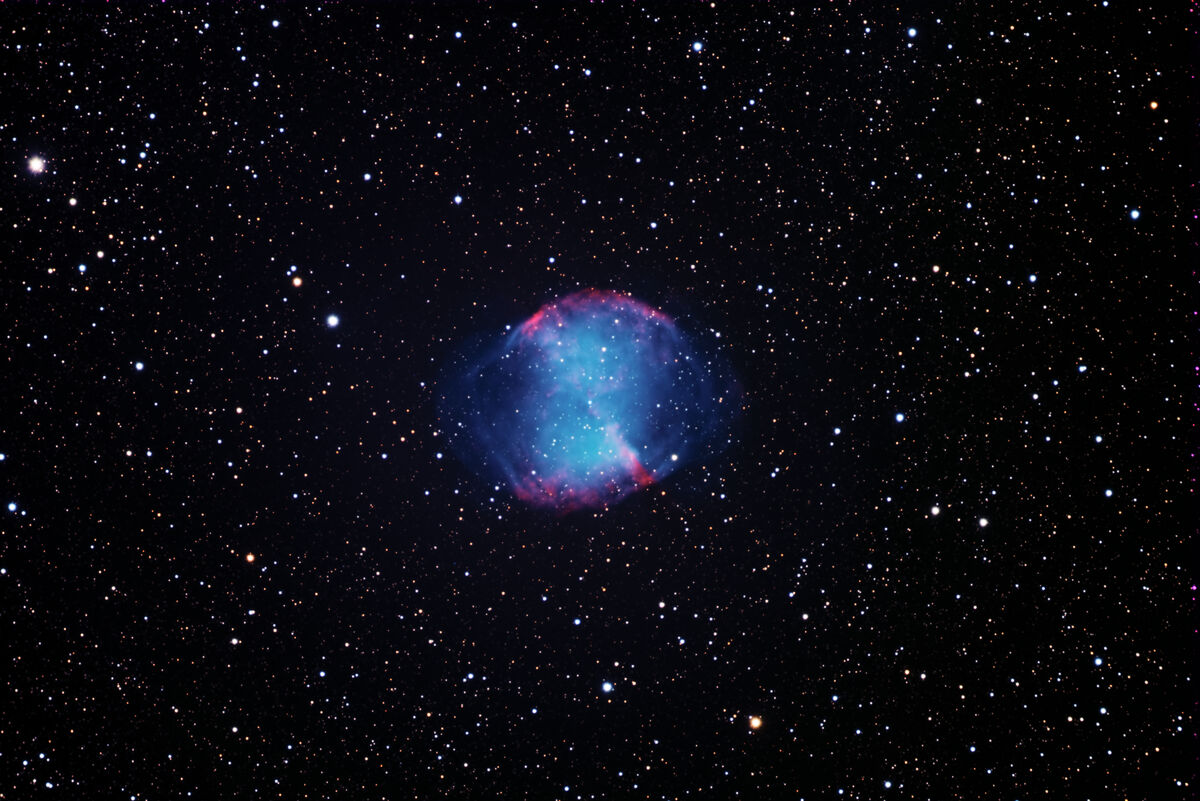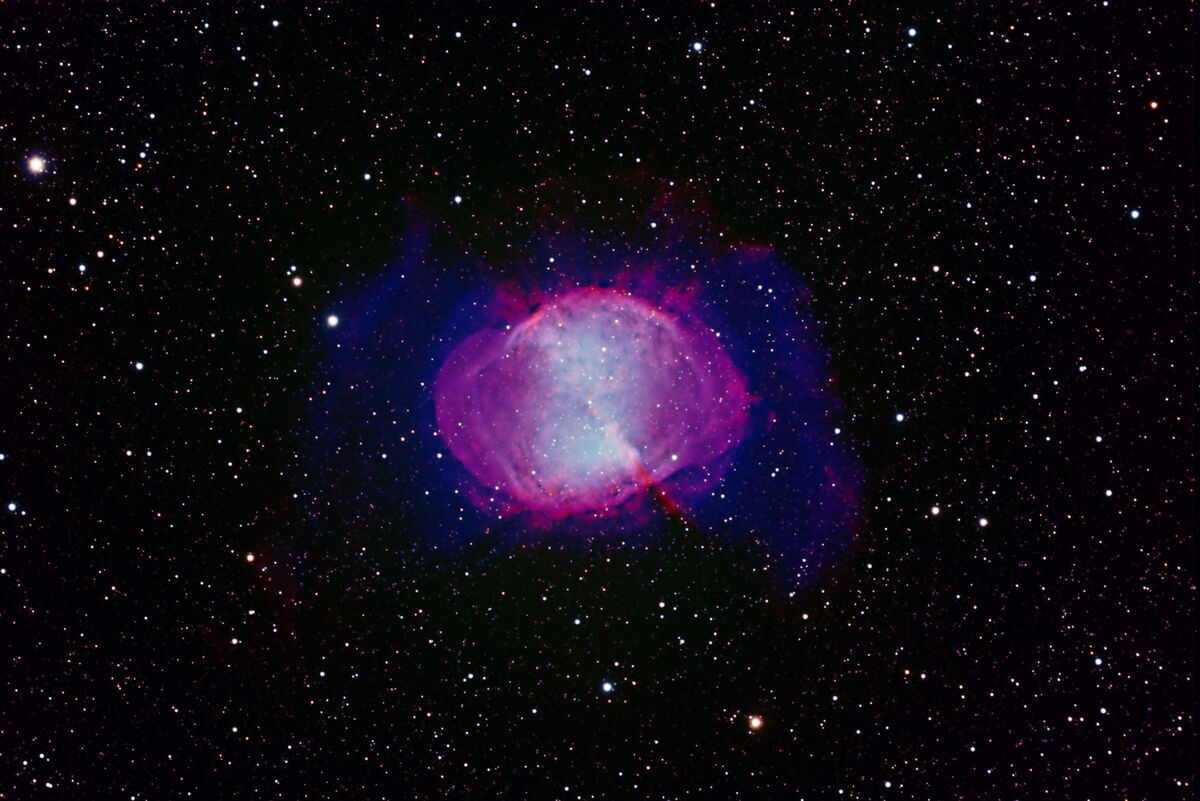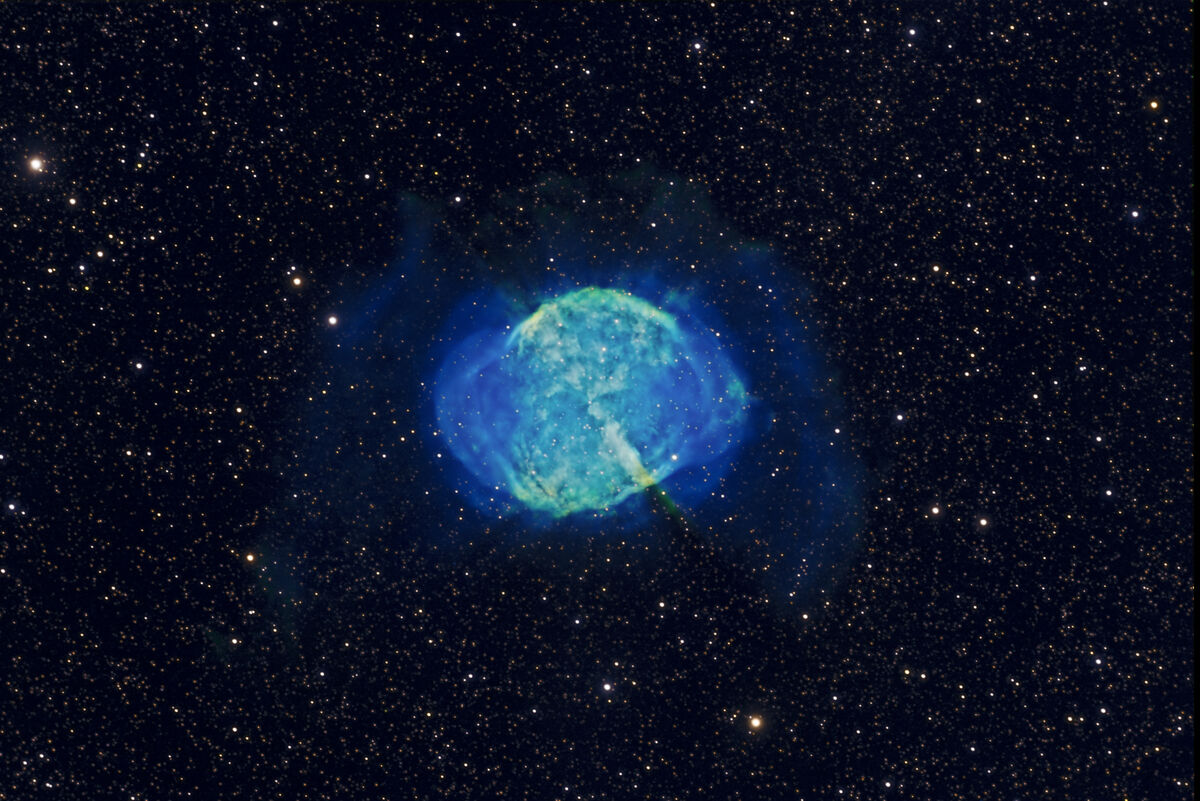Check out People Photography section of our forum.
M27 the Dumbbell Nebula in different light
Jul 29, 2023 16:42:40 #
Ballard
Loc: Grass Valley, California
M27 is a planetary nebula in the constellation of Vulpecula and is around 1360 light years away from Earth. A couple of years ago I posted a photo of M27 using a DSLR (See https://www.uglyhedgehog.com/t-652947-1.html). I've recently reshot the Nebula with a monochrome camera using multiple different filters which show more detail in the nebula.
The first image was taken using Luminance, Red, Green and Blue filters and it very similar to the one posted using a DSLR however the resolution is higher in the new image and has less noise.
The second image added in narrow band Hydrogen Alpha (Ha) data to the red Channel and Oxygen 3 (O3) data to the Blue channel, this brings out additional information in the image.
The third image was made with all Narrow Band Data, Sulphur 2 (S2) for the Red Channel, Ha for the Green Channel and O3 for the Blue channel. This combination is known as the Hubble Pallet and is not the real color of the nebula but also differentiation of the different elements since both S2 and Ha would be seen as Red to our eyes.
In this image the slight amount of S2 makes part of the image yellow when combined with the Green used for Ha.
The aqua color is the combination of the Green used for Ha and the Blue used for O3. The dim blue outer area is mainly O3.
All questions comments and suggestions are welcome.
For those interested all images were taken with a 16 inch Meade LX200 Schmidt Cassegrain telescope with a focal length of 4064 mm. The camera used was an ASI 6400MM pro monochrome camera with the temperature set to -12 C, binning set to 1x1, and gain set to 100. All appropriate Flats, dark and bias frames were used for image calibration.
The following exposures where use to capture the data. (The somewhat odd numbers are due to throwing out a few of the frames when the seeing fuzed out a bit causing the FWHM (Full width at half maximum) of the stars to get a bit bigger than the other frames.)
Luminance 91 frames each 1 minute long
Red 37 frames each 2 minutes long
Green 35 frames each 2 minutes long
Blue 40 frames each 2 minutes long
Ha 30 frames each 500 seconds long
O3 28 frames each 500 seconds long
S2 31 frames each 500 seconds long
Total exposure time 9 hours 34 minutes 18 seconds.
The first image was taken using Luminance, Red, Green and Blue filters and it very similar to the one posted using a DSLR however the resolution is higher in the new image and has less noise.
The second image added in narrow band Hydrogen Alpha (Ha) data to the red Channel and Oxygen 3 (O3) data to the Blue channel, this brings out additional information in the image.
The third image was made with all Narrow Band Data, Sulphur 2 (S2) for the Red Channel, Ha for the Green Channel and O3 for the Blue channel. This combination is known as the Hubble Pallet and is not the real color of the nebula but also differentiation of the different elements since both S2 and Ha would be seen as Red to our eyes.
In this image the slight amount of S2 makes part of the image yellow when combined with the Green used for Ha.
The aqua color is the combination of the Green used for Ha and the Blue used for O3. The dim blue outer area is mainly O3.
All questions comments and suggestions are welcome.
For those interested all images were taken with a 16 inch Meade LX200 Schmidt Cassegrain telescope with a focal length of 4064 mm. The camera used was an ASI 6400MM pro monochrome camera with the temperature set to -12 C, binning set to 1x1, and gain set to 100. All appropriate Flats, dark and bias frames were used for image calibration.
The following exposures where use to capture the data. (The somewhat odd numbers are due to throwing out a few of the frames when the seeing fuzed out a bit causing the FWHM (Full width at half maximum) of the stars to get a bit bigger than the other frames.)
Luminance 91 frames each 1 minute long
Red 37 frames each 2 minutes long
Green 35 frames each 2 minutes long
Blue 40 frames each 2 minutes long
Ha 30 frames each 500 seconds long
O3 28 frames each 500 seconds long
S2 31 frames each 500 seconds long
Total exposure time 9 hours 34 minutes 18 seconds.
LRGB image of M27

(Download)
Narrow Band Ha and O3 data added to the LRGB image.

(Download)
Hubble Pallet image of M27

(Download)
Jul 29, 2023 17:15:55 #
therwol
Loc: USA
Ballard wrote:
M27 is a planetary nebula in the constellation of ... (show quote)
Really amazing. I have a question. Did you take these pictures in Grass Valley? I would think there would be some light pollution from Auburn and nearby cities in the Sacramento Valley. I've seen what the sky looks like in remote areas, and much of what is there is obscured by light pollution here in Placerville. I can't even see the Milky Way.
Jul 29, 2023 17:16:07 #
Check out People Photography section of our forum.
Jul 29, 2023 17:19:18 #
Ballard wrote:
M27 is a planetary nebula in the constellation of ... (show quote)
Amazingly beautiful, and they're a great job, perfectly done 🏆🏆🔟🏆🏆
Jul 29, 2023 17:37:10 #
Ballard
Loc: Grass Valley, California
therwol wrote:
Really amazing. I have a question. Did you take these pictures in Grass Valley? I would think there would be some light pollution from Auburn and nearby cities in the Sacramento Valley. I've seen what the sky looks like in remote areas, and much of what is there is obscured by light pollution here in Placerville. I can't even see the Milky Way.
Hi therwol
Thanks checking out the images of M27 and for the comment. Yep I took these images from my backyard about 5 miles from downtown Grass Valley. The main glow in the sky for me is from Sacramento and a small amount from Auburn. There is also some from a bit from Grass Valley and to the west from Yuba City and Marysville. I'm in Bortle 4 skies where I live but can still make out the Milkyway in the summer and a bit of the winter milky way on the darker moonless nights in the winter. I took the LRGB images between evenings/mornings of 7/25 /2023 - 7/26/2023 before the moon got too bright. The narrow band images are much more immune to the light pollution and the moon light and were taken between evenings/mornings of 7/26 /2023 - 7/29/2023. The last useable image I got was taken this morning at 4:36AM. Note: I have automated the telescope and camera, so I don't have to stay up all night with it while it takes all the pictures.
Jul 29, 2023 17:37:52 #
Ballard
Loc: Grass Valley, California
joecichjr wrote:
Amazingly beautiful, and they're a great job, perfectly done 🏆🏆🔟🏆🏆
Hi joecichjr
Thanks for viewing the images of the Dumbbell nebula and for the comment.
Jul 29, 2023 17:38:38 #
Ballard
Loc: Grass Valley, California
Longshadow wrote:

Hi Longshadow
Thanks for checking out the shots of M27 and for the Thumbs up.
Check out Black and White Photography section of our forum.
Jul 29, 2023 21:37:33 #
Jul 30, 2023 06:52:34 #
Wow! Excellent photos, you really have the technical aspects of night sky shooting down to a science. Who needs Hubble when we've got Ballard?
Jul 30, 2023 07:20:06 #
Jul 30, 2023 09:04:40 #
Check out Professional and Advanced Portraiture section of our forum.
Jul 30, 2023 10:35:57 #
Jul 30, 2023 12:38:22 #
Ballard
Loc: Grass Valley, California
UTMike wrote:
Beautiful work!
Hi UTMike
Thanks for checking out the images of M27 and for the comment.
Jul 30, 2023 12:41:18 #
Ballard
Loc: Grass Valley, California
ELNikkor wrote:
Wow! Excellent photos, you really have the technical aspects of night sky shooting down to a science. Who needs Hubble when we've got Ballard?
Hi ElNikkor
Thanks for viewing the photos of M27 and for the comment. I don't have the resolution of Hubble but can gather similar photos, at least of a few of the larger and brighter objects.
Jul 30, 2023 12:43:45 #
Ballard
Loc: Grass Valley, California
Tdearing wrote:
Spectacular new images, thanks for posting.
Hi Tdearing
Thanks for viewing the images of M27 and for the comment. It is my pleasure to post them. I have also posted a number of different images in the Astronomical Forum.
If you want to reply, then register here. Registration is free and your account is created instantly, so you can post right away.
Check out Panorama section of our forum.




